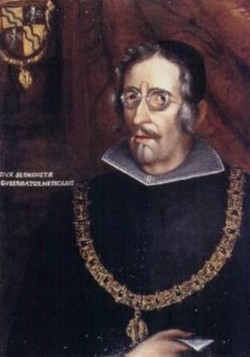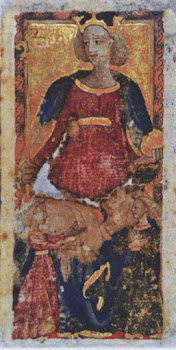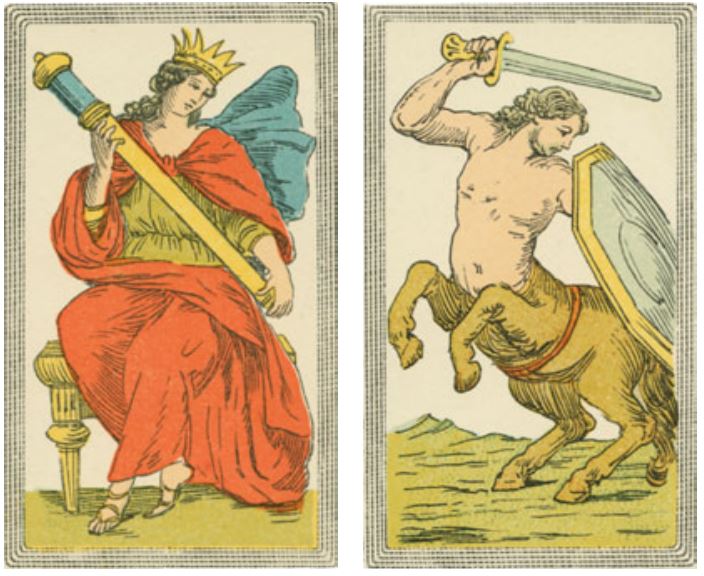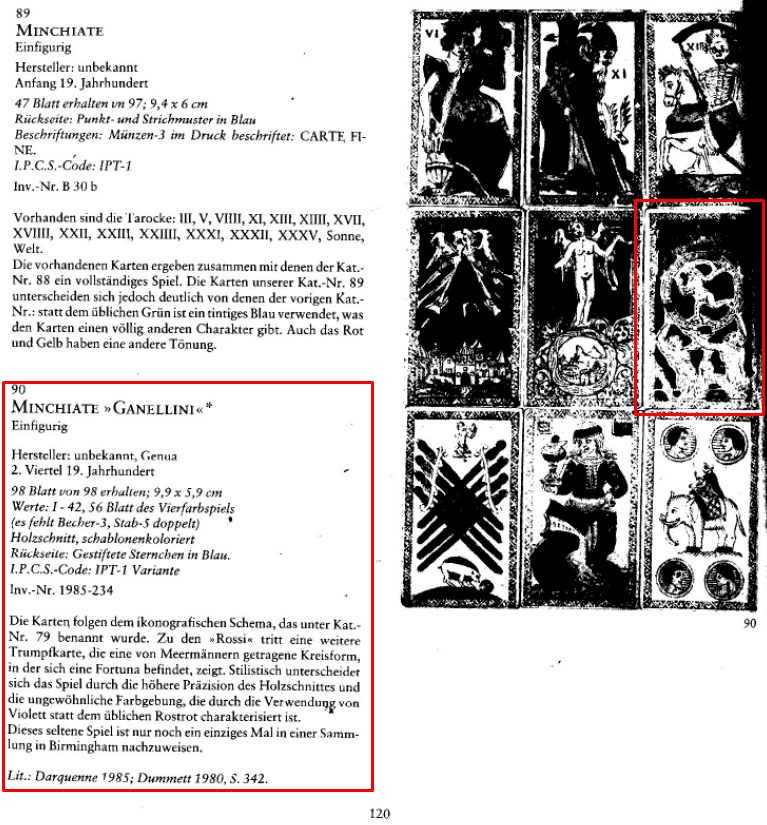Huck wrote: 30 Apr 2021, 09:59
https://www.cartorama.de/shop/kataloge/1569400253.pdf
Advertisement for an 98-cards-Ganellini deck from Faustino Solesio in the Cartorama catalog
169 Faustino Solesio, Genova. 97/98 (Ace of Coins missing). Color
lith., 98x58 mm, square corners, no
index mark. Backs: Plaid, bluish green
and brown. Circa 1930.
Lit.: Comp. Braun 793, Mann coll. 215;
Dummett [1980] p. 342; J. Darquenne in
Joker-Journal 10/85, pp. 10-13.
The minchiate died out in the 19th century, with the exception of Liguria where
they were called Ganellini. Their last and
probably sole remaining maker, F. Solesio, stopped producing them at the beginning of the 1930ies: this is why our deck
can be considered as one of the last
specimens of the species, and with
that in the very rare variant counting
98 cards that arises through a supernumerary trump.
We’ll quote Darquenne now who reports
on a deck from circa 1900 (our translation): The additional card is obviously to
rank as the 98th. Truly it can only take
that place for it belongs by virtue of its
background color to the last trumps, the
„rossi“, and the sequence of the remaining unnumbered trumps (Star-MoonSun-World-Judgment Day) is anchored in
such a rich tradition that we cannot think
of another place. The theme of the illustration assigned to that card confirms our
assumption. It shows a naked woman
running to the left, standing on a spoked
wheel (in our younger copy it is just an ornament, maybe a cloud) and holding
with both hands the ends of a ribbon that
is certainly meant to represent Fortuna’s
sail. And what would be more logical
than to crown a deck of cards with the
capricious goddess of luck?
Almost mint.
US$ 2,818.00 € 2.450,-
That's the card Nr. 98
I've a small black-white picture of the 98-card-deck in the Tarot-Tarock-Tarocchi catalog 1988 of the Leinfelden Museum. It shows a deck of second half of 19th century. Card 98 looks similar, but the world card is very different. The producer is given as unknown.
I've been busy for the past three years and have been out of the loop but this thread has piqued my interest. The Cartorama catalogue shows quite possibly only the fourth known example of the 98th card's existence. It is also the youngest of the four and the second Solesio pack. I'll put in chronological order of the four examples I'm aware of:
1. An incomplete pack of 27 cards by Francesco Fabiano, a late 18th century maker of unknown origins. Depaulis dates this to before the fall of the Republic of Genoa in 1797. The 98th card is very similar to the latest find but here are the biggest differences. Fortuna has her head turned to the right while still running to the left. The mermaid on the bottom left has only one tail. The merman on the bottom right is beardless. The other cards are in the Earlier Minchiate pattern. This was in the collection of the late Prof. Ronald Wohl and was sold in auction in 2015.
2. The anonymous complete Genoese pack circa 1825-1850 held at Leinfelden and reported by Hoffman and Dietrich in the 1988 catalogue, which I have yet to read.
3. A complete Solesio deck dated between 1896 and 1913. It was formerly in the Temperley collection. I don't know what it looks like.
4. The almost complete Solesio deck circa 1930 done in the Later Minchiate pattern. With the exception of #3&4, all other Solesio decks came with only 97 cards.
I am not sure if Dummett was referring to #2 or #3 or both when he described Fortuna's circle as being supported by two
male figures. In #1 and #4 the figure on the left is clearly female.
I mentioned this in an earlier post:
viewtopic.php?p=21036#p21036 that Ganellini was reported in Sardinia in 1759. Depaulis gives his source as
Descrizione dell'Isola di Sardegna. The earliest Sicilian source Depaulis can find is the 1753 Prammatica.












